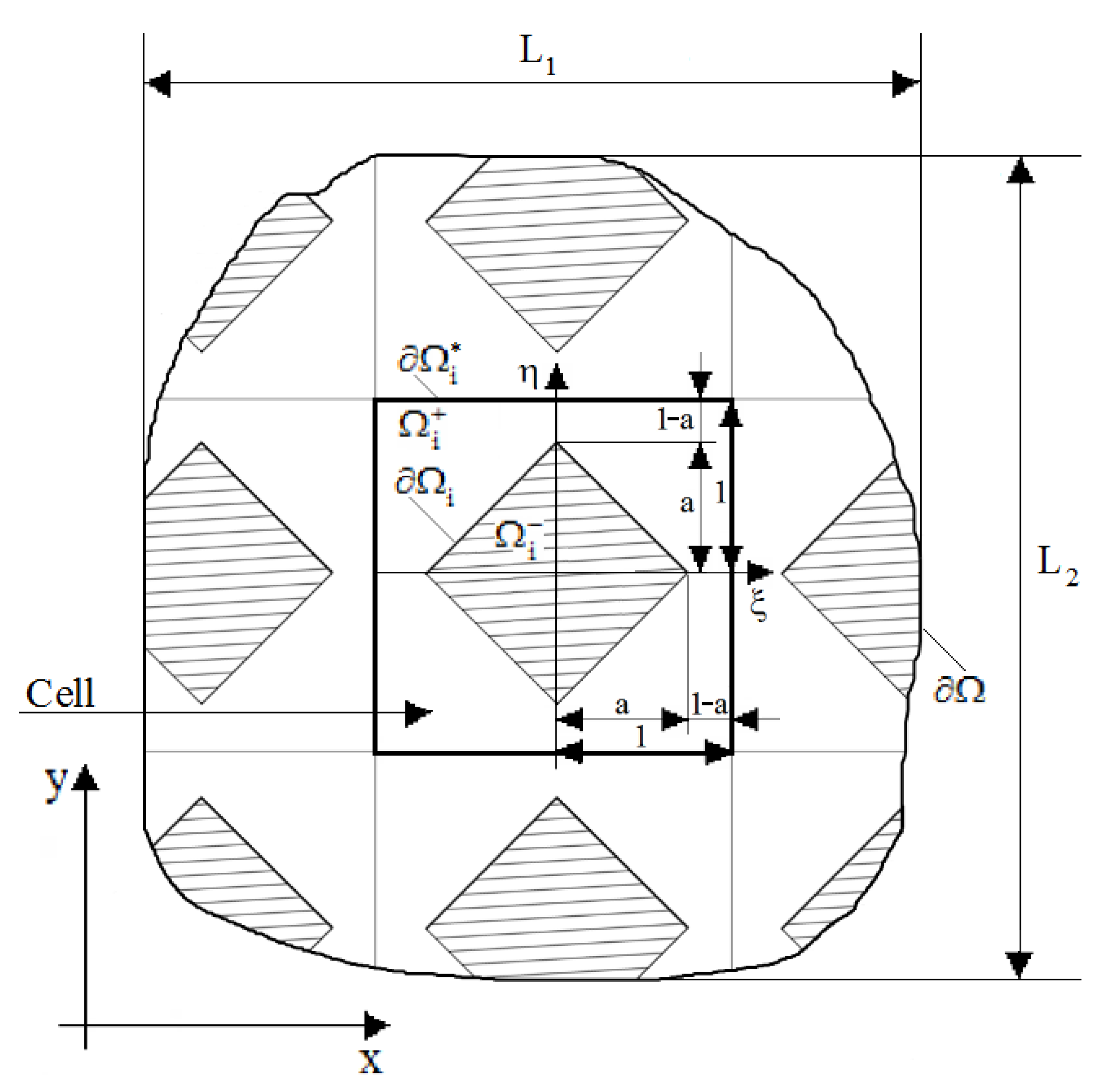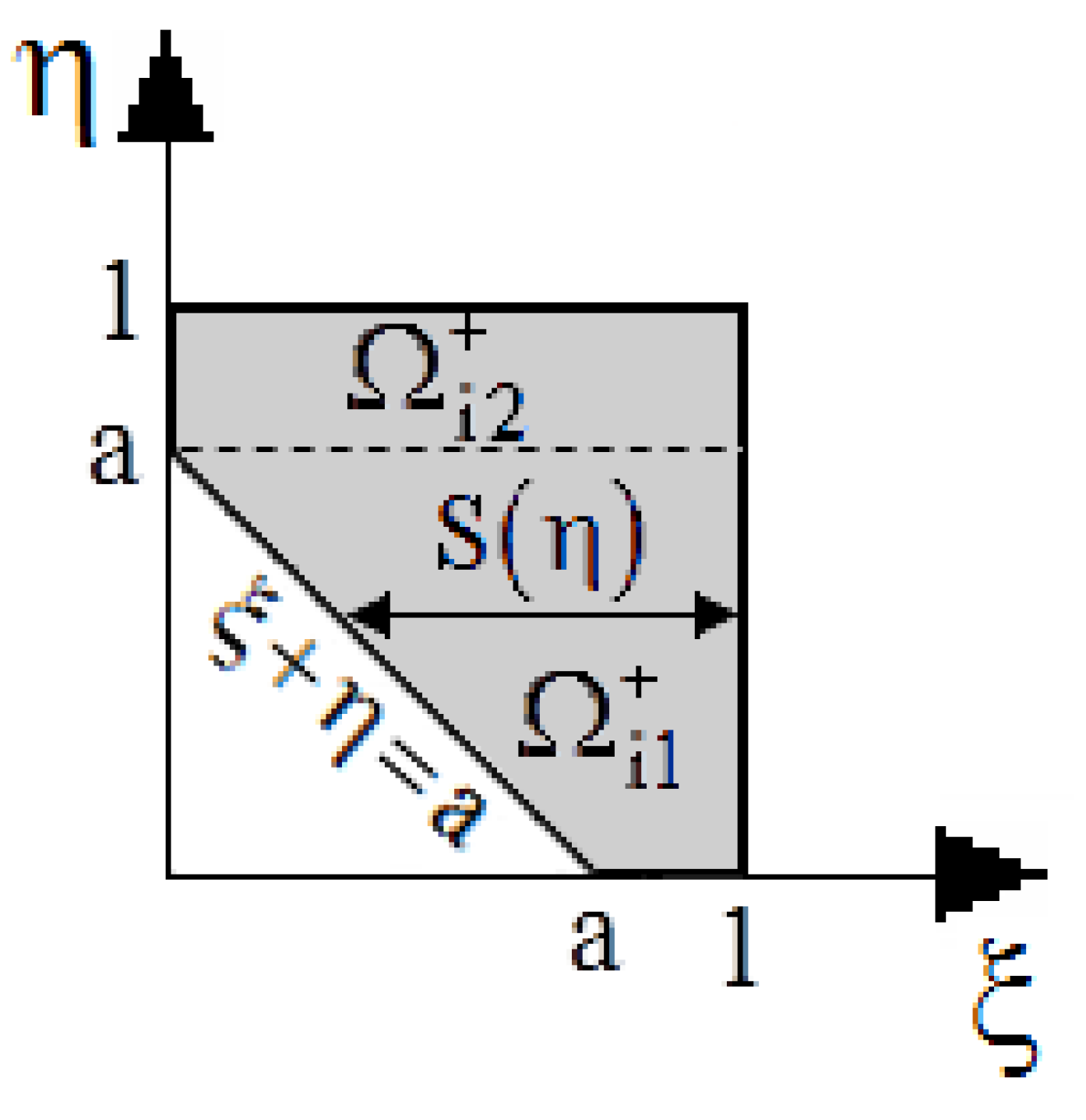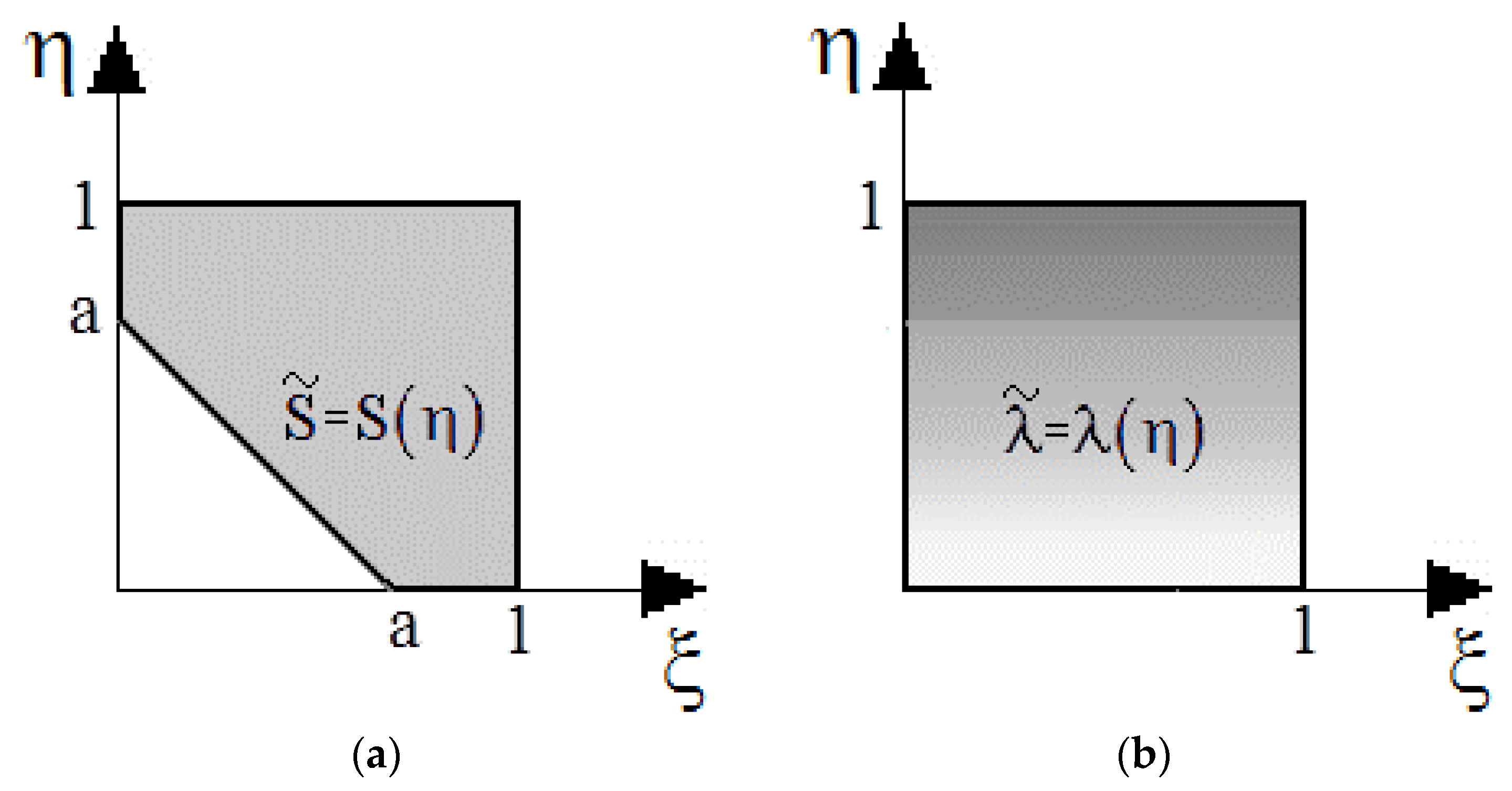Calculation of Effective Characteristics of a 2D Composite with Rhombic Voids Using an Inhomogeneous Cell Model
Abstract
:1. Introduction
- From a physical point of view, the comparison of LA and ICM can be visualized as shown for the cell of the composite in Figure 1a,b.
- At high conductivity of inclusions, the average conductivity of the composite structure is determined mainly by the conductivity of the region of inclusions. Therefore, the use of LA in this case is justified.
- If the inclusions are of low conductivity, when finding the averaged parameter of the composite, one cannot then neglect the domain of the matrix, the contribution of which is comparable with the contribution of the inclusions. Therefore, the use of LA is inappropriate here. For this case, we have developed ICM.
2. LA for Composites with Rhombic Inclusions
3. ICM for 2D Composite with Rhombic Voids
- Satisfies the periodicity condition (38).
- Does not satisfy the symmetry condition (37).
- Exactly satisfies the condition (36).
- the function is defined as the conductivity of a rod of variable cross section (domain ) from the equation:where
- The function is defined as the conductivity of a rod of constant cross section (domain ) from the equation:
- Must remove residuals, which are given by the solution of the first approximation (39) on the contour :or
- The periodicity condition on the contour must be satisfied:
- On the boundary , the relation does not satisfy condition (36), because at .
4. ICM: Physical Interpretation
5. Conclusions
Author Contributions
Funding
Institutional Review Board Statement
Informed Consent Statement
Data Availability Statement
Conflicts of Interest
References
- Panasenko, G. Multi-Scale Modelling for Structures and Composites; Springer: Berlin/Heidelberg, Germany, 2005. [Google Scholar]
- Marchenko, V.A.; Khruslov, E.Y. Homogenization of Partial Differential Equations; Birkhäuser: Boston, MA, USA, 2005. [Google Scholar]
- Kolpakov, A.A.; Kolpakov, A.G. Capacity and Transport in Contrast Composite Structures: Asymptotic Analysis and Applications; CRC Press: Boca Raton, FL, USA, 2009. [Google Scholar]
- Mityushev, V.; Andrianov, I.; Gluzman, S.L.A. Filshtinsky’s contribution to Applied Mathematics and Mechanics of Solids. In Mechanics and Physics of Structured Media. Asymptotic and Integral Equations Methods of Leonid Filshtinsky; Andrianov, I., Gluzman, S., Mityushev, V., Eds.; Academic Press: New York, NY, USA, 2022; pp. 1–40. [Google Scholar]
- Movchan, A.B.; Movchan, N.V.; Poulton, C.G. Asymptotic Models of Fields in Dilute and Densely Packed Composites; Imperial College Press: London, UK, 2002. [Google Scholar]
- Milton, G. The Theory of Composites; Cambridge University Press: Cambridge, UK, 2009. [Google Scholar]
- Christensen, R.M. Mechanics of Composite Materials; Dover Publications: Mineola, NY, USA, 2005. [Google Scholar]
- Andrianov, I.V.; Awrejcewicz, J.; Danishevskyy, V.V. Asymptotical Mechanics of Composites. Modelling Composites without FEM.; Springer Nature: Cham, Switzerland, 2018. [Google Scholar]
- Panton, R.L. Incompressible Flow, 3rd ed.; Wiley: New York, NY, USA, 2005. [Google Scholar]
- Andrianov, I.V.; Awrejcewicz, J.; Starushenko, G.A. Asymptotic models and transport properties of densely packed, high-contrast fibre composites. Part I: Square lattice of circular inclusions. Compos. Struct. 2017, 179, 617–627. [Google Scholar] [CrossRef]
- Andrianov, I.V.; Awrejcewicz, J.; Starushenko, G.A. Asymptotic models for transport properties of densely packed, high-contrast fibre composites. Part II: Square lattices of rhombic inclusions and hexagonal lattices of circular inclusions. Compos. Struct. 2017, 180, 351–359. [Google Scholar] [CrossRef]
- Awrejcewicz, J.; Starosta, R.; Sypniewska-Kamińska, G. Asymptotic Multiple Scale Method in Time Domain Multi-Degree-of-Freedom Stationary and Nonstationary Dynamics; CRC Press: Boca Raton, FL, USA, 2022. [Google Scholar]
- Vishik, M.I.; Lyusternik, L.A. The asymptotic behaviour of solutions of linear differential equations with large or quickly changing coefficients and boundary conditions. Russ. Math. Surv. 1960, 15, 23–91. [Google Scholar] [CrossRef]
- Batchelor, G.K.; O’Brien, R.W. Thermal or electrical conduction through a granular material. Proc. R. Soc. Lond. A Math. Phys. Sci. 1977, 355, 313–333. [Google Scholar]
- Drygaś, P.; Gluzman, S.; Mityushev, V.; Nawalaniec, W. Applied Analysis of Composite Media: Analytical and Computational Results for Materials Scientists and Engineers; Woodhead Publishing: Cambridge, UK, 2020. [Google Scholar]
- Keller, J.B. A theorem on the conductivity of a composite medium. J. Math. Physics 1964, 5, 548–549. [Google Scholar] [CrossRef]






Disclaimer/Publisher’s Note: The statements, opinions and data contained in all publications are solely those of the individual author(s) and contributor(s) and not of MDPI and/or the editor(s). MDPI and/or the editor(s) disclaim responsibility for any injury to people or property resulting from any ideas, methods, instructions or products referred to in the content. |
© 2023 by the authors. Licensee MDPI, Basel, Switzerland. This article is an open access article distributed under the terms and conditions of the Creative Commons Attribution (CC BY) license (https://creativecommons.org/licenses/by/4.0/).
Share and Cite
Andrianov, I.; Starushenko, G.; Kvitka, S. Calculation of Effective Characteristics of a 2D Composite with Rhombic Voids Using an Inhomogeneous Cell Model. Symmetry 2023, 15, 646. https://doi.org/10.3390/sym15030646
Andrianov I, Starushenko G, Kvitka S. Calculation of Effective Characteristics of a 2D Composite with Rhombic Voids Using an Inhomogeneous Cell Model. Symmetry. 2023; 15(3):646. https://doi.org/10.3390/sym15030646
Chicago/Turabian StyleAndrianov, Igor, Galina Starushenko, and Sergey Kvitka. 2023. "Calculation of Effective Characteristics of a 2D Composite with Rhombic Voids Using an Inhomogeneous Cell Model" Symmetry 15, no. 3: 646. https://doi.org/10.3390/sym15030646
APA StyleAndrianov, I., Starushenko, G., & Kvitka, S. (2023). Calculation of Effective Characteristics of a 2D Composite with Rhombic Voids Using an Inhomogeneous Cell Model. Symmetry, 15(3), 646. https://doi.org/10.3390/sym15030646





